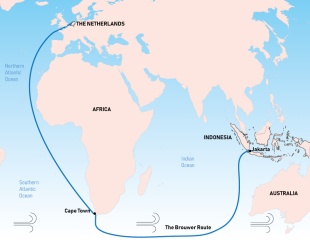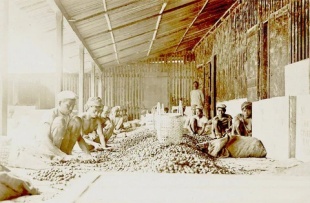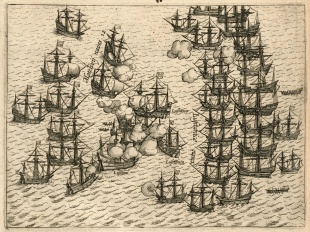DUTCH AND THE SPICE TRADE
The Dutch established a monopoly on the spice trade from the Moluccas . They gained control over the clove trade through an alliance with the sultan of Ternate in the Moluccas in 1607. Dutch occupation of the Bandas from 1609 to 1623 gave them control of the nutmeg trade. Dutch control of the region was fully realized when Melaku was captured from the Portuguese in 1641.
On the Banda Islands, the Dutch tried to trade knives, woolen clothes and other things that the Banda islander didn’t need. The Dutch demanded that they be given a monopoly and found a few complaint chiefs that signed “contracts” promising them their desired monopoly. In the meantime the English had arrived in the area and they and the Dutch tried to outmaneuver one another for control of the islands.
The Dutch could be quite ruthless when it suited their purposes. In the Bandas, one governor-general beheaded and quartered 44 local chiefs and displayed the remains in 1621 at a fort after Dutch “negotiators” were killed in a dispute over the placement of a fort on sacred site. See Jan Pieterszoon Coen Below.
In what today is eastern Indonesia, the VOC with the help of indigenous allies fundamentally altered the terms of the traditional spice trade between 1610 and 1680 by forcibly limiting the number of nutmeg and clove trees, ruthlessly controlling the populations that grew and prepared the spices for the market, and aggressively using treaties and military means to establish VOC hegemony in the trade. One result of these policies, exacerbated by the late-seventeenth-century fall in the global demand for spices, was an overall decline in regional trade, an economic weakening that affected the VOC itself as well as indigenous states, and in many areas occasioned a withdrawal from commercial activity. [Source: Library of Congress]
RELATED ARTICLES:
EARLY DUTCH PERIOD IN INDONESIA AND THE DUTCH EAST INDIA COMPANY (VOC) factsanddetails.com
DUTCH EMPIRE: WEALTH, EXPLORATION AND HOW IT WAS CREATED factsanddetails.com
END OF THE DUTCH EAST INDIA COMPANY, BRITAIN IN INDONESIA AND THE JAVA WAR factsanddetails.com
NETHERLANDS INDIES EMPIRE IN THE 19TH CENTURY factsanddetails.com
INDONESIA UNDER DUTCH RULE IN THE EARLY 20TH CENTURY factsanddetails.com
RISE OF INDONESIAN NATIONALISM IN THE EARLY 20TH CENTURY factsanddetails.com
MATA HARI factsanddetails.com
SPICES, TRADE AND THE SPICE ISLANDS factsanddetails.com
CLOVES, MACE AND NUTMEG: THE SPICE ISLANDS SPICES factsanddetails.com
INDONESIA WHEN EUROPEANS FIRST ARRIVED: SPICES, POWERFUL STATES, DEALS, ISLAM factsanddetails.com
EARLY INDIANS, CHINESE AND ARABS IN INDONESIA: IBN BATTUTA, YIJING, ZHENG HE factsanddetails.com
EARLY EUROPEAN EXPLORERS IN INDONESIA: MARCO POLO, NICOLÒ DEI CONTI, MAGELLAN'S CREW factsanddetails.com
AGE OF EUROPEAN EXPLORATION factsanddetails.com
PORTUGUESE IN INDONESIA factsanddetails.com
PORTUGAL AND THE AGE OF DISCOVERY factsanddetails.com
PORTUGUESE TRADE EMPIRE IN ASIA factsanddetails.com
Dutch Ships and Sea Routes to Indonesia

The Dutch developed quicker and more efficient southern routes between the South Africa and Indonesia that were more efficient and profitable than ones used by the Portuguese, who followed slower, seasonal coastal routes via India, and the Spanish, who wet the long way around via the Pacific and Mexico.
Holland was the world's leader in map making. The VOC hired the best mapmakers in the Netherlands to make "secret atlases" for their exclusive use. The company possessed 180 maps and charts that showed the best routes around Africa to India, China, Japan and the East Indies. The owners of the company denied the existence of the maps which were not made public until some of them were mistakenly found their into the library of Austrian aristocrat.
In the 17th century oak forests in Poland were cleared to supply wood for Dutch ships used in voyages to the East Indies, About 4,000 planks were needed for each, which lasted only one or two voyages before the wood rotted and the ship fell apart.
The Flying Dutchman was Dutch East Indies ship destroyed by a fierce storm near the Cape of Good Hope in 1680. A ghost version of ship has reportedly been seen several times. In March, 1939, for example, about 60 people on Glencairn beach in South Africa reportedly saw a 17th century ship sail towards a sandbar and then disappear. The Flying Dutchman was immortalized by a Wagner opera.
Jan Pieterszoon Coen and Ruthless Dutch Policies to Control the Spice Trade
The most influential and dynamic Dutch ruler in the early years of Dutch control of Indonesia was Jan Pieterszoon Coen, the governor general of the VOC from 1619 to 1623 and again from 1627 to 1629. Among other things he nearly wiped out the entire native population of the Banda Islands in Moluccas to keep the spice trade secret and under control; and aimed to make Jakarta into the main trading port of Asia. The latter was never realized but he is credited with instituting policies that enabled the Dutch to establish their monopoly in the spice trade in Indonesia.

Dutch factory in Ambon in the Spice Islands in the early to mid-17th century; the island was the scene of the infamous Amboyna Massacre of 1623 that put an abrupt end to the spice trade ambitions of the English East India Company in the Malay Archipelago
Coen seized the port of Jayakarta (modern Jakarta) from the sultan of Banten in western Java and established the trading post at Sunda Kelapa. Since then, it has served as the capital of the VOC, of the Netherlands Indies after 1816, and of the independent Indonesian state after World War II. Coen also developed a plan to create spice plantations using Burmese, Madagascan and Chinese labourers. Although this plan was not realized in his lifetime it too became an important aspect of the Dutch occupation of Indonesia later on.
Coen was determined to go to almost any lengths to establish and reserve a VOC monopoly of the spice trade. He accomplished his goal by both controlling output and keeping non-VOC traders out of the islands. Ambon had been seized from the Portuguese in 1605, and anti-Iberian alliances were made with several local rulers. However, the English East India Company, established in 1600, proved to be a tenacious competitor. When the people of the small Banda archipelago south of the Malukus continued to sell nutmeg and mace to English merchants, the Dutch killed or deported virtually the entire population and repopulated the islands with VOC indentured servants and slaves who worked in the nutmeg groves.
Similar policies were used by Coen's successors against the inhabitants of the clove-rich Hoamoal Peninsula on the island of Ceram in 1656. The Spanish were forced out of Tidore and Ternate in 1663. The Makassarese sultan of Gowa in southern Sulawesi, a troublesome practitioner of free trade, was overthrown with the aid of a neighboring ruler in 1669. The Dutch built fortresses on the site of the Gowa capital of Makassar (modern Ujungpandang) and at Manado in northern Sulawesi and expelled all foreign merchants. In 1659 the Dutch burned the port city of Palembang on Sumatra, ancient site of the Srivijaya empire, in order to secure control of the pepper trade. *
Spice Wars and and the Nutmeg Trade
The Dutch monopolized the nutmeg trade and kept it centered in the Moluccas. They went through great lengths to preserve their monopoly. During the Spice Wars of the 17th and 18th century the Dutch uprooted groves of nutmeg and cloves trees to keep prices high and cut their competitors out of the market. Dutch settlers were given slaves to run their plantations but were told they could not return home to Holland and were required to produce cloves exclusively for the VOC at fixed prices. Seventy large plantations were established mostly on Banda and Ai islands.
The Dutch exterminated natives unwilling to cooperate with them and burned piles of nutmeg after bumper harvests to keep prices high. They also soaked nutmeg seeds in lime so no one could plant them without their authorization. This plan was thwarted when fruit pigeons carried nutmeg seeds to other islands. To keep their monopoly intact the Dutch sent out teams to track down and destroy every last plant.
At the time the Dutch controlled the trade nutmeg was the most valuable commodity in the world after gold and silver. In the early 17th century ten pounds of nutmeg could be purchased for less than an English penny in the Banda Islanda and resold in Europe for over two pounds, a mark up of over 60,000 percent. In addition to a being a flavoring nutmeg was valued as a preservative and medicine and was said to ward off the plague.
As part of the solution to the “spice war” the 1667 Treaty of Breda was signed in which the English dropped their claim to the Bandas, where nutmeg was grown. As part of the deal the English exchanged Pulau Run, a tiny islet in the Spice Islands, for Manhattan (then known as New Amsterdam), which the Dutch had famously obtained by trading $24 worth of beads and trinkets in 1627.
The Dutch–English War of 1780, broke the VOC’s spice-trade monopoly with the Treaty of Paris, which permitted free trade in the East.
End of the Dutch Monopoly on the Nutmeg Trade
The Dutch maintained their monopoly on the nutmeg trade for two and half centuries, until the late 18th century when a French missionary smuggled nutmeg seedlings out of the Dutch East Indies and they were replanted in Madagascar, Mauritius and Zanzibar. With is move the Dutch spice monopoly was broken and the Moluccans were largely forgotten.
When the British took over the Moluccas for 12 years at the turn of the 19th century to counter the annexation of Holland by Napoleon they spread the cultivation of nutmeg to the Caribbean. By the time the Dutch reclaimed Indonesia in return for letting the British have Malaysia the damage had been done. By this time nutmeg had lost its luster anyway as its health benefits were questioned and refrigeration reduced demand for it as a preservative.
Cultivation in Grenada in the Caribbean became so big the island designed its flag with the green, yellow and red colors of the nutmeg seed and placed am image of a nutmeg seed on one side. Today, nutmeg production has dropped in the Bandas to the point there are worries it might disappear.
Image Sources: Wikimedia Commons
Text Sources: New York Times, Washington Post, Los Angeles Times, Times of London, Lonely Planet Guides, Library of Congress, Compton’s Encyclopedia, The Guardian, National Geographic, Smithsonian magazine, The New Yorker, Time, Reuters, AP, AFP, Wikipedia, BBC, CNN, NBC News, Fox News and various books and other publications.
Last updated December 2025


